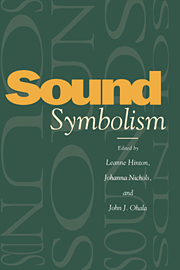Book contents
- Frontmatter
- Contents
- List of contributors
- 1 Introduction: Sound-symbolic processes
- PART I Native American languages north of Mexico
- PART II Native languages of Latin America
- PART III Asia
- PART IV Australia and Africa
- PART V Europe
- PART VI English
- 18 Phonosyntactics
- 19 Aural images
- 20 Inanimate imitatives in English
- PART VII The biological bases of sound symbolism
- Index
19 - Aural images
Published online by Cambridge University Press: 04 August 2010
- Frontmatter
- Contents
- List of contributors
- 1 Introduction: Sound-symbolic processes
- PART I Native American languages north of Mexico
- PART II Native languages of Latin America
- PART III Asia
- PART IV Australia and Africa
- PART V Europe
- PART VI English
- 18 Phonosyntactics
- 19 Aural images
- 20 Inanimate imitatives in English
- PART VII The biological bases of sound symbolism
- Index
Summary
Introduction
In Rhodes and Lawler 1981 (henceforth R&L) we sketched an analysis of English monosyllables which involved dividing them into initial consonant(s) versus the vowel nucleus plus final consonant(s). Following one of the traditional terminologies of syllable analysis, we called the initial consonant(s) the assonance and the remainder of the syllable the rime (cf. Bolinger 1950). We argued that the resulting parts fall into systems which are sound-symbolic in the sense that they participate in sound-meaning correspondences even though they are, by traditional analysis, submorphemic entities.
Many of the entities that we concentrated on in R&L have semantics that are based on vision. For example, we proposed that there is a rudimentary classifier system like that in (1) and a system of path shapes like that in (2) both of which primarily depend on the shape of objects or paths referred to.
(1) Classifiers
st- [1 dimensional] (stick, staff, stem, etc.)
str- [1 dimensional, flexible] (string, strand, strip, etc.)
fl- [2 dimensional] (flap, flat, floor, etc.)
š-/sk- [2 dimensional, flexible] sheet, scarf, skin, etc.)
n- [3 dimensional] (knob, knot, node, nut, etc.)
sp- [cylindrical] (spool, spine, spike, etc.)
dr-/tr- [liquid] (drink, drain, trickle, trough, etc.)
et al
(2) Paths
tr-/dr- [simple] (track, trip, drive, drag, etc.)
p-/b- [“anchored”] (push, pop, bump, bounce, etc.)
j-/č- [short] (jerk, jiggle, jagged, chop, etc.)
w- [back and forth] (wag, wiggle, wobble, etc.)
et al.
- Type
- Chapter
- Information
- Sound Symbolism , pp. 276 - 292Publisher: Cambridge University PressPrint publication year: 1995
- 12
- Cited by



